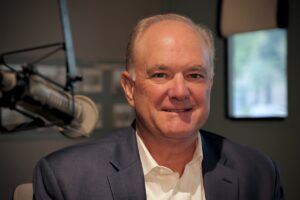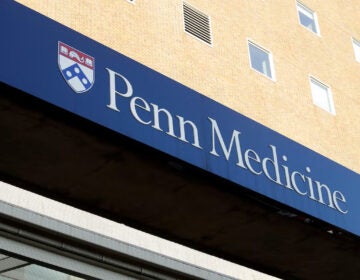Why urgent care clinics, once derided as ‘doc in a box,’ have spread like wildfire
The number of urgent care centers in the U.S. have doubled, from more than 7,000 to more than 14,000 over the last decade or so.
Listen 9:42
WHYY’s the Pulse reporter Alan Yu receives his influenza vaccine at a Vybe urgent care center in Philadelphia. (Kimberly Paynter/WHYY)
This story is from The Pulse, a weekly health and science podcast. Subscribe on Apple Podcasts, Spotify, or wherever you get your podcasts.
Find our full episode on urgent care here.
Urgent care physician Franz Ritucci remembers what it was like going to a medical conference 20 years ago, and how other doctors responded when he told them where he worked.
“I saw everyone’s eyes kind of go down. It was like, ‘ugh, an urgent care.’ That was the time when those facilities were called ‘doc in a box.’”
The “doc in the box” label hasn’t fully come off : if your family doctor is a locally-run restaurant, then urgent care is McDonald’s.
Urgent care centers have been around since the 1970s, but more recently the expansion in this sector has been explosive.
“It has grown … like fire,” said Ritucci.
Over the last decade or so, the number of urgent care centers in the U.S. have doubled, from more than 7,000 to more than 14,000, according to the Urgent Care Association.
Part of that growth comes from private equity firms, which use money from wealthy investors or large institutions to buy other companies that are not on the stock market, to try and make a quick profit.
Private equity has invested billions of dollars into hundreds of urgent care clinics across the U.S. As of 2024, more than 2,300 urgent care centers are backed by private equity investment, according to the Journal of Urgent Care Medicine.
The investment leads to more health care access and relieves busy hospitals, especially in rural parts of the country, according to the American Investment Council, an advocacy organization that represents private equity firms.
Ritucci, who is now the president of the American Academy of Urgent Care Medicine, said urgent care clinics address a previously unmet need in health care — patients who have an ear infection or a sore throat and could not easily get a last-minute appointment at their primary care doctor, but whose ailments are not serious enough to warrant an emergency room visit.
“Urgent care centers have become the reliever airport for our broken system,” Ritucci said.
There is a lot of demand for the services that urgent care clinics provide, so much so that doctors opening up their own clinics could not address it all on their own, said Peter Hotz, CEO of Vybe Urgent Care.

A few years ago, a private equity firm invested in his company and helped it grow. Today, Hotz runs 16 Vybe clinics in the Philadelphia region.
“They have never once told me or my team how to run the business, what kind of care to provide or anything like that. They’ve been really a source of capital, a source of judgment and an assistance to us as we’ve had to make challenging decisions as we grow the business.”
However, private equity investment is not always a good deal for urgent care doctors, Ritucci said. He has been in the business for so long that other urgent care doctors sometimes ask him for advice when private equity investors come calling with offers.
Ritucci tells doctors that if the business is thriving and could grow, then the investment could be good. But if the urgent care clinic is struggling and the doctor needs the investment to survive, he tells them to cut costs or close down.
He explained that if a clinic is already finding it hard to survive, then private equity investment will put more pressure on it to find more patients quickly.
“If you’re hurting that you need the money to grow, then … equity is the way and you’ll sell your soul in order to survive and move.”
Part of the pressure comes from the way private equity operates — firms are looking to turn a profit quickly, explained Jessa Loomis, an economic geographer at Newcastle University in the U.K. She has studied private equity in health care markets, including urgent care centers.
Loomis added that even if an urgent care business goes under, a private equity investor can still make a profit by selling the business or the real estate where the clinics once stood.
“Part of that is the financial engineering, financial mechanisms at play that allow them to basically take their returns and run,” she said.
Subscribe to The Pulse
Brett Murray, who works both in an emergency room and in urgent care, has become wary of private equity investment companies. He said the pressure to make money can affect patient care.
“They are in the business to make money from whatever they’re investing in. And if they don’t make money from that investment, they’re going to move on and just leave whatever is there to have happen, whatever may.”
He said he’s skeptical of private equity investors buying urgent care businesses in particular, because more and faster access to health care does not help patients much if the care is not good.
For instance, he says a lot of the time he will see patients who come into an urgent care clinic who feel ill, and want an antibiotic to feel better, but more often than not, the patient just needs time and rest to recover.
“We explain why, for example, an antibiotic might not be needed in this case. And that patient might leave feeling frustrated because they just paid whatever $300 to come to this urgent care and be told, you have a cold, you need to go home and rest and drink water and you’ll feel better eventually versus a patient who comes in and gets a prescription. They’re like, I got something. Now I’m going to suddenly feel better. I really liked that urgent care.”
Murray pointed to research showing urgent care clinics tend to prescribe more antibiotics than other health care providers. Using too many antibiotics for illnesses that don’t require them could lead to more antibiotic resistant germs, which is already a problem.
He said that is the difference between the kind of care that will leave a patient satisfied and make a profit for a business, versus the kind of care that is ultimately good for the patient and for society in the long run.
“It’s very easy to go down a slope where we’re focusing more on patients leaving good reviews and coming back because they see the visit as a success and not actually focusing on what the true medical guidelines are.”
Murray said the fast food comparison is apt, and he loves fast food, but when patients view medicine like a menu to order from, “that leads to a lot of strain on that doctor-patient relationship.”
“There’s so much mistrust of the medical system and of physicians. Lots of people saying physicians are just there to make money,” he said. “I would love if we could get back to a place where we could have a much more … productive and trusting relationship with our patients.”
WHYY is your source for fact-based, in-depth journalism and information. As a nonprofit organization, we rely on financial support from readers like you. Please give today.







